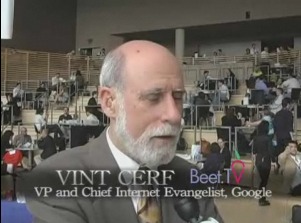At his Blog Maverick, Mark Cuban reveals the “Great Internet Lie”, which apparently is that the utopian dream of distributing “Television and Film” over the Internet is doomed. He goes on to “conclusively” prove that it’s not possible to reach Network-sized audiences (even cable network) simultaneously across the Internet.
And he’s right. Certainly I’ve got nothing to refute his numbers. Real time streaming is difficult and expensive. And totally unnecessary. Broadcast Television and its cable/satellite brethren deliver simultaneous viewing to many millions of people at a time, without incremental cost. The bigger the audience, the more profitable the show because there’s not incremental cost and bigger audiences equal more viewers for advertisements.
The trouble is, that’s trying to resolve a new problem with an old solution. (When you only have a hammer, every problem looks like a nail.) The problem that will need to be resolved in the future is “how do we deliver a broad multiplicity of program choices tailored to individual tastes and smaller per-show audience numbers?”Â
Programming has to be available when people want to watch it, not at some “appointed” time. It’s been more than five years since I watched real-time television. PVRs and digital downloads replace broadcast schedules. Even for the big-pipe broadcasters appointment television is dying. Broadcast will eventually become the home of sports (real time delivery to big audiences is highly desirable); American Idol and reality TV. These are the only shows that will garner large-enough audiences to meet the mass-audience requirement of a broadcast station or network.
 So, how do we deliver that multiplicity of program choices – from traditional and new media suppliers – to meet customer demands? None other than Vint Cerf, one of the “inventors” of the Internet, feels that the future of video on the Internet is downloading instead of streaming real time like a broadcaster.
So, how do we deliver that multiplicity of program choices – from traditional and new media suppliers – to meet customer demands? None other than Vint Cerf, one of the “inventors” of the Internet, feels that the future of video on the Internet is downloading instead of streaming real time like a broadcaster.
Already the majority of the video on the Internet is downloaded – progressive download (a.k.a. fast start) drives YouTube, Google Video and pretty much every How to and travel video website on the Internet. It’s only the traditional media folk that think emulating their old business is the way to build a new business, so Hulu and ABC.com stream. (Hint: it’s never been the case and isn’t now.)
Progressive download requires much simpler technological configurations. It’s far less sensitive to the variability of speeds on the public Internet and shared neighborhood nodes, and it meets the needs for the future, instead of the past.
Advocates of real time streaming attempt to draw a distinction between a viewing and “ownership” of a copy. Real time streaming never leaves a copy on the viewer’s hard drive; download does. But realistically a viewing = ownership (potential) has been the de facto reality since the introduction of the Betamax in 1975. Ever since then every broadcast has had the potential for people to keep a personal copy of the show. Digital only accelerates that with built-in PVRs and DVRs in cable and satellite boxes.Â
One trend that defines the current state of mass-market television is increased choice and control over viewing schedule, moving the viewer away from the broadcast or cable programmer to effectively programming their own entertainment channel. This is the trend that will increase in the future and that’s why Mark Cuban is completely right and totally missing the point.
Addition: It seems like I’m not the only one questioning Mark’s assumptions. The Forrester Blog for Consumer Product Strategy Professionals posted “Mark Cuban Goes off on the Internet Video Lie” pointing out that Broadcast and Internet delivery were complementary media. They also have links to some of their other writings on the subject.